|
|
Palma de Mallorca (pop. 350, 000) is a bustling modern city and a figurehead
for the ‘new Spain’ and its economic miracle of the last 30 years. Palma is
also the capital of the Balearic Islands (Mallorca, Menorca, Ibiza and
Formentera). The city is dominated by the gigantic cathedral of La Seu and
the modern port, packed with thousands of yachts, illustrating the
prosperity of the city.
The centre contains a completely preserved Old Town, whilst the other parts
of Palma consist of modern residential homes, business premises and
motorways. The new parts are modern and clean, with bicycle lanes and green
space. Palma is a cosmopolitan and liberal city. All things considered,
Palma de Mallorca is probably one of the best cities to live in within
Europe.
Sights in Palma de
Mallorca
The cathedral of La Seu: Overshadowing Palma is the
colossal gothic cathedral of La Seu, which is located in the old town, close
to the sea – only the state-of-the-art Parc de la Mar and city motorway
stand between the church and the port. It took centuries to build this
sacred building.
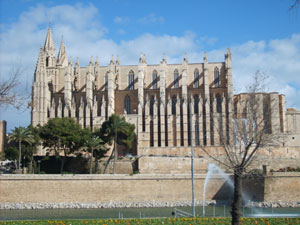
The construction began with the reintroduction of
Christianity in Mallorca in 1229, and was not completed until 100 years ago
in 1904 by the architect Antoni Gaudi. You have to pay an entrance fee to
see the cathedral of La Seu from inside (€4 in 2008), and it’s worth the
money. If you really want to save money, you could simply join a church
service....
The Palace Palau de l’Almudaina: This imposing building next to La
Seu is the second most important building in the Old Town of Palma de
Mallorca. Construction started when the Moors were still living here, and
was completed in the 13th century at the time of King Jaume II.
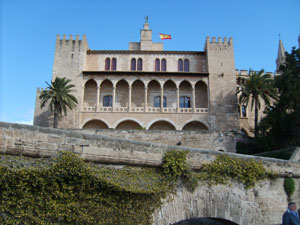
Going inside the Palau de l’Almudaina costs €4 (the same as
the cathedral of La Seu). If you cannot see both, for financial or timely
reasons, I would recommend the cathedral of La Seu. Opening times in winter
are from Monday –Friday (10am-1.15pm and 4 – 5.15pm) and in summer from 10am
– 5.45pm. At weekends the whole year opening times are only from 10am –
1.15pm.
Our page about
Ship Tours Berlin, on river
and lakes.
Parc de Mar: This ultramodern city park, built in the last 30 years,
has lots of interesting water features. You can find it behind the cathedral
of La Seu and the Palau de l’Amudaina. This is also the best spot for taking
photos of the cathedral.
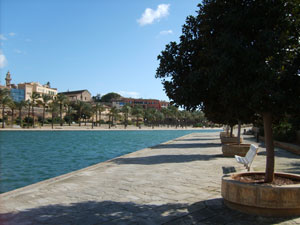
Placa Major: This is the main square of the Old Town and it has a
unique atmosphere. It’s a great place to sit down and relax in a street cafe
for a while.
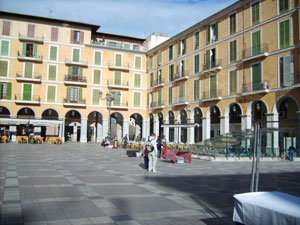
The small alleys in the Old Town: The best thing to do in the old
town is just simply strolling through the narrow streets of the Old Town.
Most of the streets are car-free, and contain interesting little shops,
houses and small things to stumble upon.
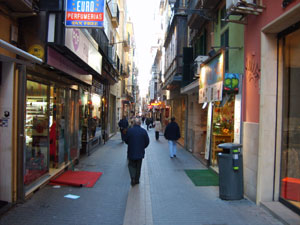
Passeig d’es Born and Passeig de la Rambla: These are the two famous
promenades of Palma de Mallorca. The Spanish enjoy taking a walk in the
evening to see and to be seen. The Passeig d’es Born and the Passeig de la
Rambla both have broad promenades and are made for this activity.
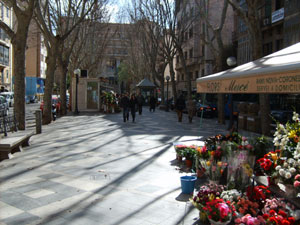
Accommodation in Palma
There is no shortage of hotels and pensions in the medium to
higher price range in Palma. For €70 or more you will have no problems
finding a double room here. It’s a lot more difficult to get cheap, single
rooms in Mallorca’s capital. There is no hostel in Palma de Mallorca.
One of the cheapest pensions – and I place I recommend – is the Hostal
Apuntadores, located in a narrow street in the centre which has the same
name as the pension (it is house number 8). A bed in the dormitory is €18
and a double room €45 (Spring 2009). If you want to stay a few days or
longer you can bargain about the price – especially in winter. The place is
run by a friendly Englishwoman who understands the needs of travellers.
Homepage: http://www.palma-hostales.com. Reservations are recommended in
popular places, even in low seasons. The rooms themselves are simple and
lack a bathroom. There is a free safe in the room, and breakfast is not
included. You can enjoy a cheap, filling breakfast on the roof accompanied
by a fantastic view of the Old Town of Palma de Mallorca.
When the Hostal Apuntadores is full you can try your luck next door in the
Hostal Ritzi. The rooms are a little better but cost more. Generally, most
backpackers visiting Palma de Mallorca stay around the small Apuntadores
Street. There are many cheap bars and restaurants around here.
Public Transport in
Palma de Mallorca
Almost all buses (city, long distance), trains and the new
underground stop at Placa d’Espanya. The Placa has been completely renovated
in the last few years, and now it is a big, modern interchange station for
public transport..
City buses: An excellent service with many bus lines and buses with cheap
prices! An important bus for tourists is #1 which goes from the airport,
then to the centre and then on to the port: a simple service. The other 30
lines serve the suburbs. The two lines which go to Europe’s biggest tourist
area (Playa de Palma) can be jam-packed even if they leave every few minutes
(#15 and #23). Prices for the city buses cost €1.17 (2007) wherever you go –
with the exception of the airport, which costs 20 cents more. You can buy
tickets at kiosks which are excellent value – 10 rides for €8 (often sold
out). The tourist office provides an excellent and free map of all bus
routes in the city.
Long distance buses: Long distance buses also leave from Placa d’Espanya.
The bus station provides a free map and time table service. There are many
buses to all the towns and the bigger villages on Mallorca. Some places are
served hourly, others only 2-3 times a day.
Train Stations: There are two stations, both on Placa d’Espanya. One is for
the museum trains to Soller, the other for modern trains is an underground
service. From here there are services every 30 minutes to Inca. Every hour
trains leave for Manacor and Sa Pobla.
Taxis: All taxis have meters in Mallorca, and the fare is similar to one
you’d expect in the UK. There are plenty of taxis.
Coaches: Horses and carriages are a trendy ‘to do’ for the richer visitors
to Palma. You’ll have to negotiate a fare with the coachman. How much it is
depends on where you’d like to go.
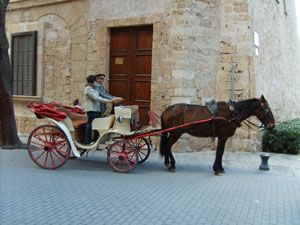
Shopping in Palma de
Mallorca
Department Store El Corte Inglés: El Corte Inglés
(“The English Yard”) is Spain’s biggest chain of department stores. The
cellar contains a food hall with plenty of food and an international
selection. The ground floor contains clothes. Floors 4 and 5 sell
electronics, cameras and sporting goods.
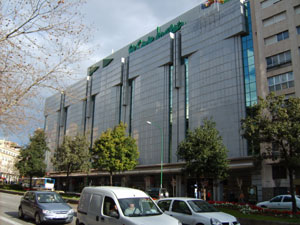
El Corte Inglés is popular with
foreigners, because things are much easier for them here. The staff usually
speak English, and the information desk on the ground floor always has
someone who can speak French and German. The prices are average. El Corte
Inglés is located very centrally, some 200m from the Placa d’Espanya.
Market Hall (Mercat de l’Olivat): Palma’s central market lies next to
the Old Town. In the Mercat de l’Olivat there is one hall just for fish,
which is an interesting sight even if you don’t plan on buying anything. In
the bigger of the buildings you can buy fruit, vegetables, meat and cheese
for rock-bottom prices. A pound of fresh strawberries – even in winter –
costs just €1.50! You can also buy tasty Spanish ham (Jamon Iberico). The
small bars offer typical Spanish tapas – an excellent opportunity for a
cheap, local lunch. The Market Hall is open in the morning only until about
12pm, and is closed on Sundays.
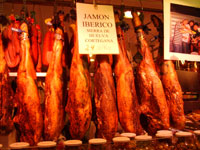


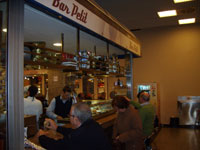
|
|











